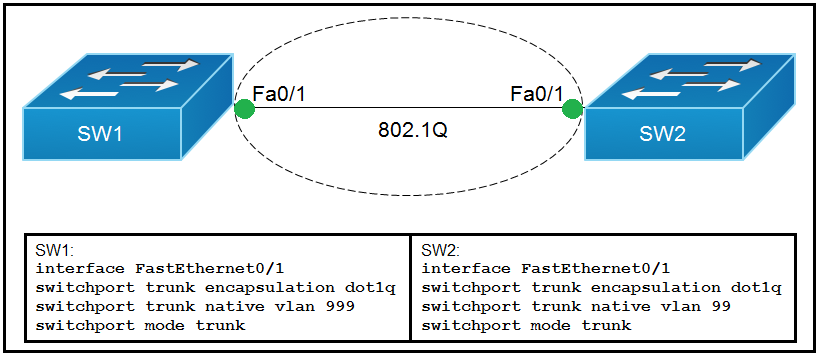
Refer to the exhibit. Which action do the switches take on the trunk link?

Refer to the exhibit. Which action do the switches take on the trunk link?
When there is a native VLAN mismatch between two switches configured as shown in the exhibit, the trunk link still forms because the essential command configurations for allowing the trunk are present. However, this mismatch results in the two mismatched native VLANs merging into one broadcast domain. For instance, SW1 sends untagged frames assuming they belong to VLAN 999, but SW2 receives them thinking they are for VLAN 99. This merging causes traffic to traverse across VLANs that are not intended to interact with each other, leading to potential network issues and security risks. Therefore, it is crucial to ensure that the native VLANs on both ends of a trunk link match to avoid such problems.
Every time i see this question... i hate it more. B is indeed the "least incorrect/bad" option but it's just a ridiculously small part of the whole answer. Meaning this would be the end result WITHOUT spanning tree existing and putting the end of the trunk that was last configured (mismatched) in a "broken status" blocking all untagged traffic on that port. Call me crazy but i hate questions where i need to envision a parallel reality where spanning tree does not yet exist.
To explain if anyone do not understand his complaint. According to Cisco STP is enabled by default on all cisco switches. Cisco documentation says STP should shut down ports when there is a native vlan mismatch. Although, I have yet to see this happen on Packet Tracer or in Lab equipment.
Thanks.
"B" is the correct answer
While B is a bit vague, this would be the general result of the native VLAN mismatch https://www.networkacademy.io/ccna/ethernet/trunk-native-vlan#:~:text=the%20Trunk%20settings%20on%20one%20switchport%20do%20not%20have%20to%20exactly%20match%20the%20settings%20on%20the%20other%20side%20of%20the%20link https://learningnetwork.cisco.com/s/article/effects-of-mismatched-native-vlans-on-a-trunk-link
B is correct
This particular question gets me confused all the time.
As I understood: If the Native VLAN is not the same on both ends of the link, a trunk will NOT dynamically form. If the trunk is formed through trunk mode (as it is here), and there is a native vlan missmatch, than the trunk will be formed but the vlans are merged to a single broadcast domain.
B is correct
B is correct
How to Avoid and Fix VLAN Mismatch Errors - LinkedIn " What are the common causes and solutions of VLAN mismatch errors? … VLAN mismatch types There are two main types of VLAN mismatch errors: native VLAN mismatch and access VLAN mismatch. A native VLAN mismatch occurs when two switches on the same trunk link have different native VLANs configured. A native VLAN is the default VLAN that carries untagged traffic on a trunk link. A native VLAN mismatch can cause traffic to be dropped, misrouted, or broadcasted to unintended devices. ..."
C is correct https://learningnetwork.cisco.com/s/article/effects-of-mismatched-native-vlans-on-a-trunk-link#:~:text=at%20receiving%20switch-,Situation%201,-The%20native%20VLAN
Another one of these. I'll keep coming back to the same link whenever I see this native VLAN mismatch. https://learningnetwork.cisco.com/s/article/effects-of-mismatched-native-vlans-on-a-trunk-link I guess I'm just going to have to interchangeably use the words restricted, shut down, and broken. I'm picking C here because of the link, but if it's B that Cisco Exam wants, then I'll pick that for the exam.